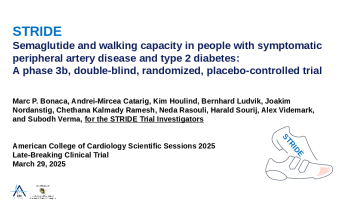STRIDE: GLP-1 Boosts Walking Capacity in Diabetic PAD Patients
While the exact mechanism is unknown, the data suggest a multitude of benefits independent of large weight loss.

CHICAGO, IL—The pool of patients who could potentially benefit from a glucagon-like peptide 1 (GLP-1) receptor agonist has expanded, thanks to new data showing that people with diabetes and symptomatic PAD achieve significant walking gains with once-weekly dosing.
Compared with patients not on treatment, those in the STRIDE trial assigned to 1.0 mg injectable semaglutide (Wegovy; Novo Nordisk) had a 13% improvement in mean walking distance, an 11% improvement in pain-free walking ability, and greater benefit on several measures of quality of life (QoL) at 1 year.
The mean increase in distance walked with semaglutide versus placebo was 87 m, or a net gain of about 40 m on a constant-load treadmill with a fixed speed and fixed incline.
“To put that into context, a change on the flat, 6-minute walk test that would be clinically meaningful for this population would be 20 meters,” STRIDE lead investigator Marc P. Bonaca, MD (University of Colorado Anschutz Medical Campus, Aurora), said in a press conference prior to the presentation here at the American College of Cardiology (ACC) 2025 Scientific Session. “This is double that and it's on a 12% grade [incline]—so walking up a hill—which would be about twofold the metabolic equivalent of work. So, it's a large absolute delta.”
He added that body mass index (BMI) was relatively low overall in the trial participants, but even those with a low or normal BMI at study entry saw consistent walking and QoL benefits with the GLP-1. The advantages were apparent at 6 months, and the curves continued to diverge over the year of follow-up.
The manuscript was simultaneously published in The Lancet.
Sahil Parikh, MD (NewYork-Presbyterian/Columbia University Irving Medical Center, New York, NY), who was not involved in the trial, called the STRIDE findings provocative, but added that it’s not clear how semaglutide improves function in patients with PAD.
“STRIDE adds to the body of evidence that GLP-1s are advantageous from a cardiovascular performance standpoint, but the exact mechanisms are yet unknown,” Parikh noted. “It’s exciting that we’re seeing benefits in this population, but I would like to see mechanistic studies, such as an assessment of arterial stiffness, a look at energetics, which can be done with various nuclear studies, or even a more reproducible, graded exercise assessment.”
Bonaca and colleagues say the study builds on evidence suggesting that the anti-inflammatory effects of GLP-1s, which have been demonstrated in other patient populations, may be in play in the peripheral vasculature. Inflammation is thought to play an important role in claudication, while ischemia that results from claudication has been shown to promote inflammation. Tamping down inflammation with a GLP-1 drug could provide a pathway for improving functional status, they say, particularly if it occurs early in the PAD disease course.
There also have been suggestions in studies like FLOW that semaglutide may impact vascular function, in addition to the broad cardiometabolic benefits seen in nondiabetic patients in trials like SELECT.
Forty meters doesn't sound like a lot, but I am telling you it is a lot. Joshua A. Beckman
For the STRIDE participants, ankle-brachial index (ABI) also improved in the semaglutide group, building a case for a non-weight-based impact of the drug. While the exact means by which GLP-1s may be exerting an effect independent of weight loss are curious, Eugenia Gianos, MD (Lenox Hill Hospital, Northwell Health, New York, NY), told TCTMD in a press conference prior to the presentation, it may be difficult to prove and may not even be necessary.
“In these PAD patients, just by virtue of the fact that they're able to walk further and they improve their glycemic control, . . . there's so many different aspects that could be contributing to improved circulation,” she said. “As a clinician, I would say you don't really care too much [about the mechanism] since it has so many different benefits.”
Improvements Across the Board
STRIDE randomized 792 patients (mean age 67 years; 25% women) from outpatient clinics in 20 countries in North America, Asia, and Europe. Approximately 60% of patients had been living with diabetes for 10 years or longer and had an BMI < 30 kg/m². Bonaca described the population as well-treated overall, with high rates of statin use, as well as antiplatelets and anticoagulants.
At baseline, all patients had early-stage symptomatic PAD (Fontaine class IIa), with the ability to walk pain-free for 200 meters or more on a flat treadmill, median maximum walking distance of 185.5 m, and pain-free walking distance of 114.5 m on a constant-load treadmill with a fixed speed of 2 miles per hour and fixed incline of 12%. A normal distance for a healthy patient, Bonaca and colleagues suggest, is more than 600 m to 800 m.
The mean ABI was 0.75, and the mean toe-brachial index (TBI) was 0.48. Approximately 25% of patients had a history of lower limb revascularization, 65% had moderate or severe limitations in walking, and 63% reported that the impact of PAD on their health-related QoL as measured by the Vascular Quality of Life Questionnaire-6 (VascuQoL-6) was moderate or severe.
Functional assessment was conducted at baseline, 26, 52, and 57 weeks.
In addition to the improvements in maximum walking distance and median pain-free walking distance, Bonaca showed that there was a 54% lower rate of PAD disease progression leading to rescue therapy with medication or revascularization.
CV risk factors, including systolic BP, HbA1c, and BMI all were lower in the semaglutide group compared with placebo. For QoL, improvements were seen on both the VascuQoL-6 (P = 0.011) and the 36-Item Short Form Health Survey (P = 0.013). ABI ratio in the semaglutide group saw a greater shift from baseline compared with placebo (P = 0.0037).
As a clinician, I would say you don't really care too much [about the mechanism] since it has so many different benefits. Eugenia Gianos
There hasn’t been a new drug for PAD in about 25 years, making semaglutide, with its established safety profile and growing list of benefits, a welcome addition to the armamentarium for vascular specialists, said Bonaca.
“I don't think everybody really understands how much even what we describe as ‘mild claudication’ limits patients, but when you do physical component scores, they feel as poorly as patients with New York Heart Association class III heart failure,” said Joshua A. Beckman, MD (UT Southwestern Medical Center, Dallas), the designated commenter for the study in the late-breaking trial session.
That’s important to bear in mind when looking at the improvements in walking among the STRIDE participants, he added.
“Forty meters doesn't sound like a lot, but I am telling you it is a lot,” Beckman said, recalling that many heart failure clinicians were “ecstatic” over 14-meter gains in walking distance in the recent STEP-HFpEF DM trial among those on semaglutide compared with placebo.
He further commented that the improvements in ABI appear to be the first that have been seen in PAD patients on semaglutide and likely would not have been thought possible without these data to support them.
Beckman concluded that “we now have in one agent a medication that will make people feel better and walk better,” something he is eager to convey to PAD patients.
L.A. McKeown is a Senior Medical Journalist for TCTMD, the Section Editor of CV Team Forum, and Senior Medical…
Read Full BioSources
Bonaca MP, Catarig A-M, Houlind K, et al. Semaglutide and walking capacity in people with symptomatic peripheral artery disease and type 2 diabetes (STRIDE): a phase 3b, double-blind, randomized, placebo controlled trial. Lancet. 2025;Epub ahead of print.
Disclosures
- The trial was funded by Novo Nordisk.
- Bonaca reports research grant/consulting funding to his institution from Abbott, Agios, Alexion, Alnylam, Amgen, Angionetics, Anthos Therapeutics, ARCA Biopharma, Array BioPharma, AstraZeneca, Atentiv, Audentes Therapeutics, Bayer, Better Therapeutics, Bristol Myers Squibb, Cambrian Biopharma, Cardiol Therapeutics, CellResearch Corporation, Cleerly, Cook Regentec, CSL Behring, Eidos Therapeutics, EPG Communication Holdings, Epizon Pharma, Esperion Therapeutics, Faraday Pharmaceuticals, Foresee Pharmaceuticals, Fortress Biotech, HDL Therapeutics, HeartFlow, Hummingbird Bioscience, Insmed, Ionis Pharmaceuticals, IQVIA, Janssen, and Lexicon Pharmaceuticals, MedImmune Limited, Medpace, Merck, Nectero Medical, Novartis, Novo Nordisk, Osiris, Pfizer, PhaseBio, PPD Development, Prothena Biosciences, Regeneron, Regio, Sanifit Therapeutics, Sanofi, Silence Therapeutics, Stealth BioTherapeutics, VarmX, Virta Health, and WraSer.






Comments